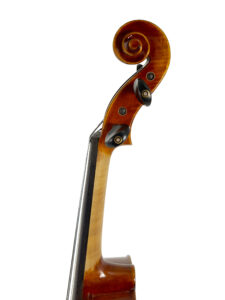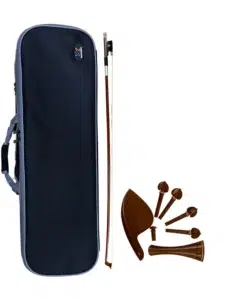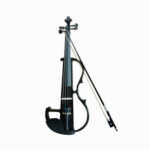Selecting the right strings is crucial in violin performance, as the material and manufacturing process of strings can significantly impact the violin’s tone. The following will introduce different brands of violin strings, including steel, nylon, and synthetic strings, and their differences, advantages, and characteristics.
String Tension
String tension refers to the force applied longitudinally (axially) on the strings, determined by the mass of the material wound on the strings and the required vibration frequency. String tension affects the playability and tone of the strings. Violin strings available in the market typically offer different tension levels, categorized as low, medium, and high.
How Does Tension Affect Sound?
Compared to low-tension strings, high-tension strings produce a louder and fuller sound under the same bowing conditions. However, because high-tension strings have higher mass, they require more bowing force and are less responsive to bowing. As a result, high-tension strings can be more challenging to control, especially for gentle playing. On the other hand, low-tension strings may have a smaller volume but usually offer a richer tone and are easier to control.
Steel Strings:
Steel strings are a type of violin string made from steel, typically wrapped with metal, silver, or copper. They are substantial and stable, allowing players to produce clear tones and maintain pitch accuracy.
Advantages and Characteristics of Steel Strings:
Stability: Steel strings produce highly stable sound, maintaining pitch accuracy even in different climates and humidity conditions, which is crucial for professional players.
Tone: Steel strings have a bright and clear tone, suitable for various musical styles.
Different Brands of Steel Strings:
Pirastro:
A well-known string brand, Pirastro strings are generally firmer in feel compared to Thomastik strings manufactured in Austria. Players may require more hand strength when using Pirastro strings.
Evah Pirazzi, often referred to as the “green beauty,” is mainly designed for solo performers. It significantly enhances the vibrancy and resonance of the violin if your violin’s vibrations are insufficient or its tone is relatively dull. However, if your violin already has excellent tone and resonance, using Evah Pirazzi strings may have the opposite effect, making the sound too muted. These strings are typically used to improve the originally dull tone of older violins, giving them more brightness. Their drawback is that their tonal performance usually lasts only about two to three months (comparatively, Thomastik strings may have a slightly longer lifespan).
Chromcor: Commonly known as the “green stripe,” endorsed by artist Natalie MacMaster. It is one of the most famous steel strings, known for its durability and loud and clean tone. These strings are highly robust.
Flexocor-Permanent: Often called the “red tail.” It is a very stable entry-level steel string, but it is now rarely used for violins. It produces a warm and clear sound projection and is liked by many young players.
Perpetual: Also known as “永恒” in Chinese. Priced similarly to Evah Pirazzi, it features a platinum E string and comes with a detachable ball end. The A string is available in two variations: regular aluminum and steel or chrome steel. The A string produces a rounder, more colorful sound. Overall, these strings provide a new and distinct feel compared to other Pirastro strings. They are recommended for 4/4 violins only.
German Lenzner:
Lenzner is most famous for its E-strings, and the company is more renowned for its guitar strings. The Optima Goldbrokat (around ten dollars each) is a good companion for Thomastik Dominant ADG strings. It used to be the favorite E string of the famous violinist Heifetz. It’s a cost-effective option.
Austrian Thomastik:
Peter Infeld is also known as PI (referring to the mathematical constant pi). These strings offer rich tones and blend power and elegance with a wide dynamic range and innovation in terms of tone and sound quality. These strings are highly responsive to bowing and have excellent tuning stability. They provide a soft left-hand feel that allows the player to fully express themselves. They come in various finishes, including silver-plated, gold-plated, and a unique platinum-plated option. They are widely used on older violins and are favored by renowned violinists like Lenn Dicterow and James Ehnes.
Nylon Strings:
Nylon strings are typically made from nylon material and offer a unique tone and playing feel. They are suitable for specific musical styles and performance needs.
Advantages and Characteristics of Nylon Strings:
Nylon strings usually have a warm and gentle tone, making them suitable for musicians seeking a warm and expressive sound. They are often more beginner-friendly than steel strings, making them a good choice for beginners and young players.
Different Brands of Nylon Strings:
Pirastro Tonica:
Tonica (priced between 100-200) is an affordable option from the Pirastro brand, making it suitable for beginners and young players. It is endorsed by legendary violinist and Curtis violin professor Aaron Rosand, who particularly likes the silver-wound D string in Tonica. These strings have lower tension and are suitable for many new violins.
Wondertone Solo: These strings have improved core materials from brands like Evah Pirazzi, Obligato, Passione, and Blue String. They produce a more direct, bright, and clean sound without the “whistling” background noise. These strings offer smooth transitions between the E and A strings and are known for their resemblance to the sound of the old Russian school of soloists. Many players use these strings, and if you’re interested, you can find online recordings to get a feel for their sound.
Synoxa: These strings produce a clean and bright sound, with agile sound response and quick tuning.
Austrian Thomastik:
Dominant Nylon Strings: These strings offer exceptional sound quality and rapid responsiveness. They can produce expressive tones, making them suitable for solo and chamber music performances. They maintain a stable pitch even in varying weather conditions.
ᅠ
Slovakian Warchal:
Larsen Tzigane Nylon Strings: These strings produce a warm and rich sound with outstanding expressiveness. They are suitable for emotionally expressive performances. Larsen Tzigane strings are carefully crafted, have a longer lifespan, and are less prone to breaking or wearing out.
Nefrit (priced under 150): Combining the characteristics of metal and composite (nylon) strings, the EA string is metal, and the DG string is composite. These strings have higher tension and are suitable for players who use a lot of pressure during their performance, including electric violin players.
Dominant:
135B: Very stable strings with a tone close to Dominant’s signature sound. They have a relatively long lifespan (although the D and G strings may have slightly shorter lifespans) and are consistent on different violins. They have moderate tension and volume, making them suitable for various players.
Synthetic Strings:
Synthetic strings are typically composed of various synthetic materials designed to provide a warm and expressive tone similar to gut strings but with greater stability and durability.
Advantages and Characteristics of Synthetic Strings:
Synthetic strings usually offer a rich tone reminiscent of gut strings, with warmth and expressiveness while also maintaining stability. They produce a deeper and more resonant sound, focusing on solo performance, with an emphasis on sound projection, boldness, and distinctiveness.
Different Brands of Synthetic Strings:
Austrian Thomastik:
Vision Titanium: Titanium metal solo strings are wound on advanced synthetic cores for easy left-hand fingering due to a high-polish surface. These strings produce focused, pure, and beautiful upper-string sounds, making them suitable for solo performances. They offer quick tuning and unmatched tuning stability. They are more durable than most synthetic core strings and are highly responsive. The ball end is made of titan-aluminum alloy. Notable artists endorsing these strings include Laurie Carney and Robert Uchida.
D’Addario:
Zyex Synthetic Strings: These strings offer a balanced tone, combining warmth and clarity, suitable for a wide range of musical styles. They have a richer harmonic content and are more agile, less affected by humidity and temperature changes. Zyex strings usually have a fast response, making it easier for players to control dynamics and musical expression.
Danish Larsen:
Virtuoso: These strings, endorsed by renowned female violinist Alina Pogostkina, produce a more “solo” sound and have been reformed in terms of their synthetic core to provide greater agility. The E string is made of carbon steel, and the DG strings are made of pure silver.
Slovakian Warchal:
Nefrit (priced under 150): Combining the characteristics of metal and composite (nylon) strings, the EA string is metal, and the DG string is composite. These strings have higher tension and are suitable for players who use a lot of pressure during their performance, including electric violin players.
Summary
When selecting the right violin strings, players should consider their musical style, performance needs, and personal preferences. Different brands of strings offer a wide range of options to cater to the needs of various players, whether they are professional performers or students. The best choice depends on your performance goals and tonal preferences.






